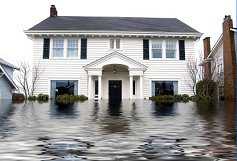by Lauren Patzer, Copyright © SurviveAnyDisaster.com.
Imagine some strange plague takes out the natural predators of insects. Perhaps a trillion birds die off and the flying bugs of our world swarm and attack everything that moves. Or maybe a strange virus knocks out all the bats of the planet, and mosquitoes run amok, sucking the blood out of everything they can find, spreading disease and pestilence as they go – West Nile, Malaria, etc.
What if smaller mammals are suddenly struck down and all the creepy crawly creatures explode their populations, unhindered by the mouse, rat, cat and raccoon? Think of the multitudes of ants, roaches, and other various insects that typically invade the modern home multiplied by a million. Suddenly faced with a bug apocalypse, infestations and insect invasions would suddenly be a common event.
Imagine something even more likely – a weather phenomenon that fails to reduce the population of many insects, resulting in an explosion of their number, more than their natural predators can handle. Or an invasive insect species enters a geographic area with no natural predators, expanding as far as food sources can support it.
Docile insects mate with a devastating hostile like species, creating a super prolific killing machine. These scenarios are happening now – with the mild winters, international travel and cross border crossbreeding bringing all of these biblical level plagues to reality.
Attack of the Ants
Typically, an ant problem is small and localized. A quick application of insecticide eliminates them. This is several hundred or even thousands of ants from one or two colonies pestering you home. But what if the threat is in the millions or billions? Mild winters have let species that live above ground multiply unhindered. That means they'll need food and water – and you've got a great source of both inside your home.
Overuse of insecticides can lead to health problems for you, so what are some natural remedies for keeping the ants away? Common spices are actually a great deterrent in the kitchen – apply a little cinnamon, red chili powder, black pepper or mint to your countertops and the ants will avoid it. Seal any place in your home where ants might enter, keep trash sealed and away from the house, and don't leave food lying around. A clean house is an ant food free house. Other natural methods you may consider include bay leaf dipped in mint mouthwash placed in your pantry, mint and cloves planted in window sill gardens and outdoors, and the ever curious Vaseline, chalk and baby powder sprinkled around doors and windows is something ants won't cross. Using a cotton swab with peppermint or spearmint oil on it dabbed anywhere you see ants will keep them away too.
Believe it or not, ants are valuable in controlling other pests in your house like spider, moth, flea, bed bug, fly and silverfish larvae. So eliminating ants altogether is not a great idea, but controlling their access to your food is.
Mosquitoes
It actually doesn't matter if your winter is mild or not, what really matters to mosquito breeding are how wet your spring and summer is. Last year saw a relatively dry spring and summer in many places, so much so that drought conditions were common and so were mosquito free evenings. This year looks like a reverse of that trend, meaning the little flying blood suckers will be out in great numbers! Outside of removing any stagnant water you can see, there isn't much else you can do about reducing the number of mosquitoes, but you can keep them away with a variety of techniques.
Wear bright colors during the day (they are attracted to dark colors like blue and green, so try yellow, orange or pink). Don't wear perfumes or perfumed lotions or moisturizers – the sweet scent mixes with your sweat and attracts many flying insects. Bug sprays are somewhat effective, but creating a barrier in your backyard is even better – plant catnip, marigolds, rosemary and mints in your garden, use citronella candles around outside gatherings, use 5 drops lemon eucalyptus oil and spray yourself with the solution instead of bug spray. If it's night time, long sleeves and pants can provide an extra layer of protection any time of day and a barrier of mosquito netting does wonders to allow you to see through the netting, but keep the little buggers out.
Bees
Crossbred killers from across the border have been steadily migrating north into the United States. The new bees that are winning the war are more violent and apt to attack at the slightest provocation. But, they're still bees and there are ways you can keep them from buzzing around your property.
Bees are attracted to a simple number of things – eliminating these from your yard (or replanting away from areas people frequent) is a good way to control your exposure. Standing water, pollen carrying trees and flowers, anything resembling nectar (like soda or beer cans), and deep grassy places that bees like to build hives in or near. Even swimming pools can be effectively made unattractive to bees by using an algae control chemical according to manufacturer's directions to reduce surface tension of the water, so bees can't land, collect and leave, but drown instead. Covering your pool when not in use helps too.
Strange weather makes for even stranger bug fellows, so keep an eye out for that biblical plague of insects and in the meantime take the proper precautions to keep your home and your family safe from more scaled down "outbreaks".
Strange Phenomenon
Stranger phenomenon might call for extraordinary measures: What if the insects are of unusual size and number, something out of a horror movie perhaps? Or a true Biblical plague from the hand of God? It's possible the only things you can do is board up and seal your house and wait for the invasion to pass. But then, that only happens in books and horror movies right? Well...
Nightmare Insects
The Siafu Ant is the largest ant in the world. Known as the army ant, it has jaws that can clamp onto prey and not let go, even after the ant has been ripped in two. Their jaws are so strong they are used as needles to stitch wounds together in Africa. This deadly insect travels in columns by the millions, killing and consuming everything in its path. The only effective defense is to get out of the way like the elephants do.
The Japanese Giant Hornet is just like its name says – giant! It has a stinger up to 1.6 inches long, a wing span up to 2.5 inches, and just 30 of them can devastate a normal bee colony of over 30,000 bees. In Japan, where they are also known as the Giant Sparrow Bee, they kill more humans than any other animal in all of Japan. They can fly up to 25 miles per hour and emit a pheromone alerting other nearby hornets to join in the hunt. You can run, but not fast enough, so you better be able to get inside somewhere safe so you only have one to deal with.
For sheer disease-spreading efficiency, the mosquito is the deadliest killer of all insects. Malaria, dengue fever, yellow fever and West Nile Virus are all spread by mosquitoes, with Malaria killing an average one million people every year. Mosquito netting, chemical repellents including DEET and generous use of citronella candles and torches appear to be the only effective deterrents to these blood suckers.








